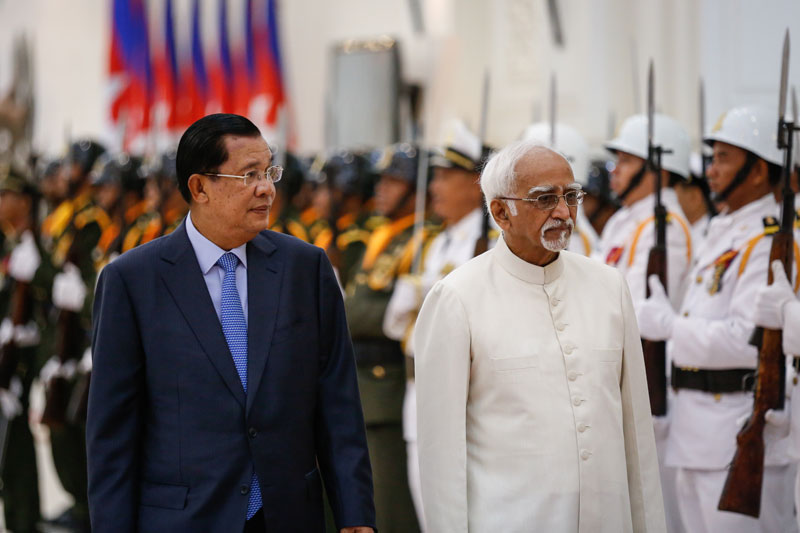India is set to bring new development opportunities to Cambodia as it challenges China’s established influence in Southeast Asia, experts say.
Under the administration of Prime Minister Narendra Modi, India has prioritized stronger economic and political relations with its eastern neighbors—upgrading its “Look East” foreign policy stance to the more proactive “Act East” strategy.
–Business Analysis

“India understands that it cannot just sit on the fence; it will have to take a participatory role,” said Pankaj Jha, a research director at the Indian Council of World Affairs in New Delhi and the author of “India and China in Southeast Asia: Competition or Cooperation.”
“There are really two narratives for India’s greater involvement in the region—one is economic and the other is defense,” Mr. Jha said.
“The CLMV [Cambodia, Laos, Myanmar and Vietnam] countries are low-base economies. Therefore, there is scope to develop their manufacturing, and connect it to India,” he added. “India is also taking a more active stance on the South China Sea, to act as a natural mediator.”
Cambodia’s geostrategic position places it in close reach of both China and India—a potential market that is home to nearly 40 percent of the world’s population—offering ample opportunity for economic dividends. With greater regional integration, Cambodia stands to gain from new investment and trade, and a larger market for its goods and services.
Yet India’s economic foothold in the country is weak compared to China’s, its influence is defined mainly by its ancient Hindu imprints on famed temples and Bollywood dramas regularly aired on local television.
Despite India’s 2009 free trade agreement (FTA) with Asean, Cambodia accounted for just 0.2 percent of India’s total trade with the bloc in 2013, according to the Export-Import Bank of India. And U.N. data shows that India accounts for less than 1 percent of Cambodia’s total stock of foreign direct investment inflows.
If India is serious about expanding its sphere of influence eastward, it must first address numerous domestic challenges, according to Faisel Pervaiz, South Asia analyst at the Texas-based global intelligence firm Stratfor.
“India has a much weaker manufacturing base compared to China, which limits New Delhi’s ability to link with Asean” Mr. Pervaiz said in an email.
“India’s decentralized democratic structure and weak business environment [it currently ranks 130th on the World Bank’s ease of doing business index] mean that it is far more limited in being able to coordinate with Indian business.”
Mr. Pervaiz noted, however, that in the long term, as India tackles its domestic constraints and expands its Asean footprint, it could play an important role by balancing China’s influence in the region.
And amid China’s slowing economic growth, Cambodia and the rest of the region would welcome growing ties with India, the Organization for Economic Cooperation and Development says in its report “Economic Outlook for Southeast Asia, China and India 2016,” released last month.
“To sustain [Asean’s] robust [growth] momentum, the region will need to weather China’s slowing growth, which will continue to affect the rest of region’s growth prospects,” the report says.
“Enhancing regional ties can play a key role in maintaining the growth momentum” as Chinese export demand drops and investment flows decline, it says, adding that “growth in India [between 2016 and 2020] is expected to pick up to one of the highest levels in the region.”
India is already showing greater intent to engage with its eastern neighbors.
It has strengthened diplomatic ties with Asean members and announced plans to promote Indian private sector investment in CLMV countries, while the frequency of Indian delegations arriving to survey opportunities in Cambodia has also grown, said Sandeep Majumdar, vice president of the Indian Chamber of Commerce in Cambodia.
“With the ‘Act East’ policy, we are seeing a lot of delegations arriving in Cambodia for trade and investment opportunities,” he said. “But the figures are not satisfactory —last year, there was only around $160 million total trade between India and Cambodia.”
While Indian companies have traditionally focused on exporting pharmaceutical products to Cambodia—with all of the major Indian brands available in the country—they are beginning to export and invest in a broader array of industries, Mr. Majumdar said.
“Now, delegations are arriving from a range of Indian states and want to invest in varied sectors including textiles, renewable energy, infrastructure and agriculture,” he said.
“Cambodia is the only country in Southeast Asia that allows 100 percent foreign ownership. It is close to India and stable. The forthcoming Asean Economic Community will give businessmen access to a market of 600 million people,” he added.
And despite China’s entrenched presence in Cambodia, Mr. Majumdar believes that Indian companies have advantages over Chinese firms, with a command of English language and opportunities for vocational and I.T. training.
With negotiations for the Chinese-led Regional Comprehensive Economic Partnership—a proposed FTA between Asean and Asean’s FTA partners—expected to conclude in 2016, India and China’s interests are likely to come closer together as they shift more production to Southeast Asia to support their burgeoning middle-class populations.
Cambodia’s government, while enjoying particularly cozy ties with China—its largest aid and FDI provider—remains open to diversifying its investment opportunities, said Chum Sounry, spokesman for the Ministry of Foreign Affairs.
“We want to maintain relations and cooperation with both China and India,” Mr. Sounry said. “We welcome investors from all around the world—and we wish to promote ties with India, particularly in trade and FDI.”
While India faces domestic challenges as it looks to expand eastward, Cambodia’s private sector will enjoy the long-term benefits of investment, trade, new markets and the transfer of skills, Mr. Majumdar said.
“We are just beginning. India-Cambodia ties are at a turning point,” he said. “The world is seeing that there is positive change in India—and its effect will be global.”



